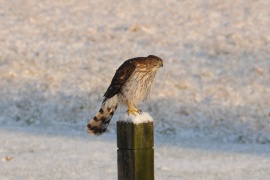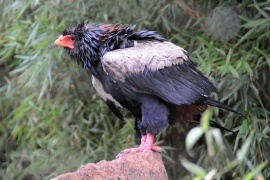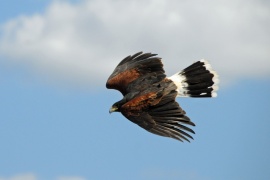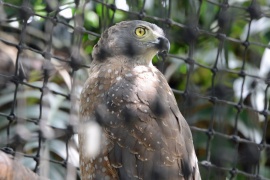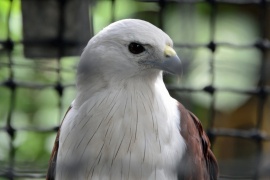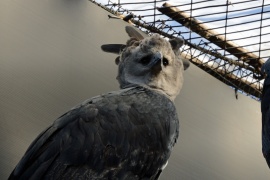AY Honors/Raptors/Answer Key
Template:AY patch unavailable
Template:Honor desc
1. What does the word “raptor” mean?
The word Raptor comes from the Latin word rapere, meaning to seize, or snatch away. The term is used in reference with the way many raptors kill their prey with their feet.
Raptors include hawks, eagles, kites, vultures, condors, harriers, kestrels, falcons, owls and the secretarybird. Raptors are often referred to as birds of prey, as they are frequently active hunters (aside from the vultures and condors, which are primarily carrion eaters). A common characteristic among raptors are their sharp, curved talons for catching and holding prey, their curved upper bill for tearing flesh, and often their keen eyesight, hearing and/or sense of smell, used for finding their food.
2. Classification:
a. Identify the 2 major groups of raptors.
Raptors are divided into two broad groups, the diurnal raptors (those active in the day), such as hawks, eagles, kites, falcons and osprey, and the nocturnal raptors (those active at night), which comprise the typical owls and the barn owls.
b. List the scientific names of the orders & families collectively referred to as "raptors" or "birds of prey."
Raptors are currently divided into three Orders under the Class Aves:
Order Accipitriformes (accipiter, from the Latin word meaning hawk)
- Family Accipitridae: including the hawks, eagles, and kites, some 217 species worldwide
- Family Cathartidae (cathartes, from the Greek word meaning purifier): the seven species of vultures and condors
- Family Pandionidae (Pandion, from the Greek legend, the father of Procne, changed into a swallow): the two species of Osprey
- Family Sagittariidae (Sagittarius, Latin for archer): One species of Secretarybird
Order Falconiformes (likely from falx, from the Latin meaning sickle, referring to the curved beak)
- Family Falconidae: Some 60 species of falcons and their allies, including the Caracaras
Order Strigiformes (strix, from the Greek meaning to screech)
- Family Strigidae: Some 124 species of owls worldwide
- Family Tytonidae (Tyto, from the Greek for owl): The ten species of Barn Owls
c. Identify distinct characteristics of raptors.
d. an example of a raptor that illustrates each of the families represented under these two major groups (7 families).
Use this to find how many of each family are in your area, and then see of you can find them. Some examples include:
- Accipitridae: The largest and most diverse family of raptors. Includes the Bald Eagle, Red-Tailed Hawk, and Mississippi Kite, among others. Below are a small selection of raptors found in the Family Accipitridae.
- Cathartidae: There are seven recognized species in the Family Cathartidae: Turkey Vulture (Cathartes aura), Lesser Yellow-Headed Vulture (Cathartes burrovianus), Greater Yellow-Headed Vulture (Cathartes melambrotus), Black Vulture (Corygyps atratus), California Condor (Gymnogyps californianus), King Vulture (Sarcoramphus papa) and the massive Andean Condor (Vultur gryphus)
- Pandionidae: There are now two recognized species of Osprey (formerly there was only one recognized species): the more common Western Osprey (Pandion halietus), and the Easter Osprey (Pandion cristatus), which occurs between Sulawesi, Australia and New Caledonia.
- Sagittariidae: There is only one species in this family, the Secretarybird (Sagittarius serpentarius), found in Africa.
- Falconidae: Falconidae are divided into two sub-families, Falconinae and Polyborinae. The former has four genera, and includes the ubiquitous Peregrine Falcon (Falco peregrinus), the Merlin (Falco columbarius) and the American Kestrel (Falco sparvarius), as well as the tiny Black-Thighed Falconet (Microhierax fringillarius). The Polyborinae comprises seven genera, and includes the Crested Caracara (Caracara cheriway) and the Barred Forest Falcon (Micrastur ruficollis).
- Strigidae comprises some 27 genera of “typical” owls in three sub-families, and includes the massive Eurasian Eagle-Owl (Bubo bubo), the Great Grey Owl (Strix nebulosa), the tiny Northern Pygmy Owl (Glaucidium gnoma) and the equally diminutive Elf Owl (Micrathene whitneyi), and the Great Horned Owl (Bubo virginianus).
- Tytonidae is divided into two sub-families, each with just a single genus. Among the Tytonidae are the Oriental Bay Owl (Phodilus badius), the Common Barn Owl (Tyto alba), and the Australian Masked Owl (Tyto novaehollandiae).
